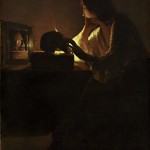In 17th-century Europe, many artists drained their paintings of bright colors, creating drama instead through strong contrasts of light and dark. This installation of six paintings in the European art galleries makes it easy to see how narrowing the light source focuses our attention on a key gesture or action. In Saint Sebastian Tended by Saint Irene, attributed to the French artist Georges de La Tour and his studio, the holy woman gently removes an arrow from the young soldier, who has been persecuted for his Christian faith. A similar sense of private drama is seen in Bernardo Strozzi’s Hagar and the Angel, in which an abandoned young woman’s desolation is ended by the miraculous appearance of an angel. In both of these paintings, light is the vehicle for our privileged view; it is also the symbol of deliverance and hope after a lonely trial.
The controlled sense of drama and heightened emotional effect was also effective in non-religious paintings. A Dutch artist recorded the urgency and chaos generated by a real-life catastrophe in the town of Delft in his painting
The Burning City. A more interior mood is conveyed in paintings of everyday life, in which two boys play with bubbles or a woman seals a private letter by candlelight.












